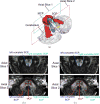Segmentation of the Cerebellar Peduncles Using a Random Forest Classifier and a Multi-object Geometric Deformable Model: Application to Spinocerebellar Ataxia Type 6
- PMID: 25749985
- PMCID: PMC4873302
- DOI: 10.1007/s12021-015-9264-7
Segmentation of the Cerebellar Peduncles Using a Random Forest Classifier and a Multi-object Geometric Deformable Model: Application to Spinocerebellar Ataxia Type 6
Abstract
The cerebellar peduncles, comprising the superior cerebellar peduncles (SCPs), the middle cerebellar peduncle (MCP), and the inferior cerebellar peduncles (ICPs), are white matter tracts that connect the cerebellum to other parts of the central nervous system. Methods for automatic segmentation and quantification of the cerebellar peduncles are needed for objectively and efficiently studying their structure and function. Diffusion tensor imaging (DTI) provides key information to support this goal, but it remains challenging because the tensors change dramatically in the decussation of the SCPs (dSCP), the region where the SCPs cross. This paper presents an automatic method for segmenting the cerebellar peduncles, including the dSCP. The method uses volumetric segmentation concepts based on extracted DTI features. The dSCP and noncrossing portions of the peduncles are modeled as separate objects, and are initially classified using a random forest classifier together with the DTI features. To obtain geometrically correct results, a multi-object geometric deformable model is used to refine the random forest classification. The method was evaluated using a leave-one-out cross-validation on five control subjects and four patients with spinocerebellar ataxia type 6 (SCA6). It was then used to evaluate group differences in the peduncles in a population of 32 controls and 11 SCA6 patients. In the SCA6 group, we have observed significant decreases in the volumes of the dSCP and the ICPs and significant increases in the mean diffusivity in the noncrossing SCPs, the MCP, and the ICPs. These results are consistent with a degeneration of the cerebellar peduncles in SCA6 patients.
Figures







Similar articles
-
SEGMENTATION OF THE COMPLETE SUPERIOR CEREBELLAR PEDUNCLES USING A MULTI-OBJECT GEOMETRIC DEFORMABLE MODEL.Proc IEEE Int Symp Biomed Imaging. 2013 Dec 31;2013:49-52. doi: 10.1109/ISBI.2013.6556409. Proc IEEE Int Symp Biomed Imaging. 2013. PMID: 24443683 Free PMC article.
-
Patterns of fractional anisotropy changes in white matter of cerebellar peduncles distinguish spinocerebellar ataxia-1 from multiple system atrophy and other ataxia syndromes.Neuroimage. 2009 Aug;47 Suppl 2:T72-81. doi: 10.1016/j.neuroimage.2009.05.013. Epub 2009 May 14. Neuroimage. 2009. PMID: 19446636
-
Microstructural MRI Basis of the Cognitive Functions in Patients with Spinocerebellar Ataxia Type 2.Neuroscience. 2017 Dec 16;366:44-53. doi: 10.1016/j.neuroscience.2017.10.007. Epub 2017 Oct 12. Neuroscience. 2017. PMID: 29031602
-
Bilateral effects of unilateral cerebellar lesions as detected by voxel based morphometry and diffusion imaging.PLoS One. 2017 Jul 10;12(7):e0180439. doi: 10.1371/journal.pone.0180439. eCollection 2017. PLoS One. 2017. PMID: 28692678 Free PMC article.
-
Probing the neuroanatomy of the cerebellum using tractography.Handb Clin Neurol. 2018;154:235-249. doi: 10.1016/B978-0-444-63956-1.00014-X. Handb Clin Neurol. 2018. PMID: 29903442 Review.
Cited by
-
Quality Assurance using Outlier Detection on an Automatic Segmentation Method for the Cerebellar Peduncles.Proc SPIE Int Soc Opt Eng. 2016 Feb 27;9784:97841H. doi: 10.1117/12.2217309. Epub 2016 Mar 21. Proc SPIE Int Soc Opt Eng. 2016. PMID: 28203039 Free PMC article.
-
Degenerative Ataxias: challenges in clinical research.Ann Clin Transl Neurol. 2016 Nov 17;4(1):53-60. doi: 10.1002/acn3.374. eCollection 2017 Jan. Ann Clin Transl Neurol. 2016. PMID: 28078315 Free PMC article. Review.
-
Sensitivity of Diffusion MRI to White Matter Pathology: Influence of Diffusion Protocol, Magnetic Field Strength, and Processing Pipeline in Systemic Lupus Erythematosus.Front Neurol. 2022 Apr 26;13:837385. doi: 10.3389/fneur.2022.837385. eCollection 2022. Front Neurol. 2022. PMID: 35557624 Free PMC article.
-
A Bayesian approach to fiber orientation estimation guided by volumetric tract segmentation.Comput Med Imaging Graph. 2016 Dec;54:35-47. doi: 10.1016/j.compmedimag.2016.09.003. Epub 2016 Sep 19. Comput Med Imaging Graph. 2016. PMID: 27671948 Free PMC article.
-
On the Cut-Off Value of the Anteroposterior Diameter of the Midbrain Atrophy in Spinocerebellar Ataxia Type 2 Patients.Brain Sci. 2024 Jan 5;14(1):53. doi: 10.3390/brainsci14010053. Brain Sci. 2024. PMID: 38248268 Free PMC article.
References
-
- Awate SP, Zhang H, Gee JC. A fuzzy, nonparametric segmentation framework for DTI and MRI analysis: With applications to DTI-tract extraction. IEEE Transactions on Medical Imaging. 2007;26(11):1525–1536. - PubMed
Publication types
MeSH terms
Grants and funding
LinkOut - more resources
Full Text Sources
Other Literature Sources
Miscellaneous

